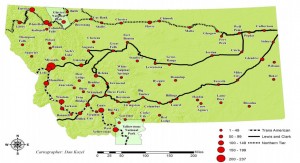Those travelers who crisscross Montana by bicycle leave a lot of money behind as they go, spending on average between $75 to $102 a day.
That according to “Analysis of Touring Cyclists,” a study by the Institute for Tourism and Recreation Research at University of Montana in cooperation with the nonprofit Adventure Cycling Association, based in Missoula.
The study’s findings are just another example of how bicycle travel has a positive economic impact, especially on the small communities through which many bicyclists pass.
The study concludes:
“Economically, small town communities could see considerable gains from drawing in touring cyclists to their community. Cycle touring could provide economic impacts, albeit a small niche of travelers, which would not be seen if the community did not attempt to draw in this market.”
Twin Bridges
As an example, the study cites the case of Twin Bridges, population 375, in southwestern Montana. A local resident, the late Bill White, had noticed lots of bicyclists passing through town, located at the intersection of the TransAmerica and Lewis & Clark trails. He convinced the town to create the Twin Bridges Bicycle Campground in a riverfront park there in 2009 to give cyclists a place to rest, shower and pitch a tent.
“In turn, this has led to increased spending in restaurants/bars and grocery stores in the community,” the study reports. As for other small communities that see bicycle traffic, “Encouraging local community leaders to embrace this niche market can provide a better experience for the cyclists and bring economic benefits to local residents who may not see as many traditional tourists throughout the year.”
Good and bad memories
The study was based on a survey of people who had visited or contacted Adventure Cycling Association over a three year period. Of those who had visited Montana by bike, the largest age group (54%) was 55-64 years old. Twenty-eight percent were solo travelers, while those in tour groups accounted for 16%.
The most frequently visited location was Glacier National Park (41%) followed by Yellowstone National Park (37%). They remarked on the scenery, the challenge of the passes, the friendly local residents, and hospitality. Many said that pedaling the Going to the South Road at Glacier National Park would be a lasting memory.
The most frequent complaints involved road shoulder widths and presence of rumble strips along the side of the road. Most often cited were Highway 93 into Whitefish, US Route 2 across the state, and the east and west entrances to Glacier National Park.
“Often the most difficult part of a cyclist’s trip was dealing with being forced to bike in the road to the left
of the white line, many times with high-speed traffic. While people commented on their love of cycling
in Montana due to scenery and friendliness of locals, shoulders and rumble strips caused some to fear
for their safety and for a few this means they will not return.”
Recommendations
The study recommends that the state improve road conditions so cyclists can feel safe riding on the highways. It also says small communities could benefit from bicycle tourism by providing amenities geared to bicyclists.
The study, released in December, notes that cyclists reported occasional bad encounters with drivers. It recommends educating the public to accept bicyclists on roadways.
This Montana study is another in a recent list that points to the benefits of bicycle travelers to the local economies. Others studies have been done in Oregon, Wisconsin, Arizona and Iowa. In each case, the study finds that visiting bicyclists benefit the state’s economy.


2 pings
[…] More states and regions are discovering bicycle touring boosts local economies. Studies in Montana, Oregon, Arizona and Michigan all found positive economic impacts from bike […]
[…] another study not cited in the map determined that bicycle travelers in Montana spend $75 to $102 a day as they ride across the […]